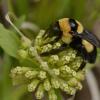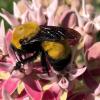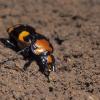Once thought to be extinct, the Fender’s blue butterfly was known only from collections made between 1929 and 1937, until it was rediscovered in 1989 by Paul Hammond. Fender’s blue is a butterfly that formerly thrived in the prairies of Oregon’s Willamette Valley, but during the past 140 years an estimated 99 percent of this native prairie has been turned into farmland or otherwise developed.
Habitat loss from agriculture and urban development poses the greatest threat to the Fender’s blue. Another major threat to the butterfly is the invasion of exotic plants. Invasive species, such as Himalayan blackberry and Scotch broom, have been outcompeting and displacing the Kincaid’s lupine and other native wildflowers in upland prairies where the butterflies live.
Taxonomic Status
(Lepidoptera: Polyommatinae: Polyommatini)
Icaricia icarioides fenderi Macy, 1931.
The Fender’s blue is a small butterfly in the family Lycaenidae (gossamer-wings), with a wingspan of about one inch. The upperside of the wings of male Fender’s Blue butterflies are predominately iridescent sky blue. Females have rusty brown wings. The dorsal surface of both sexes have a black border within a white fringe and the underside is pearly gray to dirty chalk, with black and brown spots, outlined in white.
The Kincaid’s lupine (Lupinus oreganus var. kincaidii)—a wildflower formally listed as threatened because of extensive habitat loss—is the primary larval host plant and is critical to the survival of this butterfly. Caterpillars have also been found on sicklekeeled lupine (Lupinus albicaulis) and the longspurred lupine (Lupinus arbustus). Adult butterflies begin laying their eggs, primarily on the Kincaid’s lupine, during the month of May. Once the larvae hatch, the caterpillars feed briefly until the plants begin to senesce in early July. At that time, they drop to the base of the plants and enter diapause (a stage in the butterfly’s life when its growth and development are suspended) for the fall and winter. In February or March the larvae come out of diapause and continue their development. The larvae then enter their pupal stage and subsequently emerge as adult butterflies in May. A Fender’s blue butterfly completes its life cycle in one year.
The Fender’s blue is endemic to the native upland prairies of the Willamette Valley in Oregon. Only one-tenth of one percent of the original habitat once available to the Fender’s blue and Kincaid’s lupine, or approximately 400 hectares of prairie, exists today.
Fender’s blue lives primarily in the upland prairies of Oregon’s Willamette Valley.
Xerces Red List Status: Critically Imperiled
Other Rankings:
Canada – Species at Risk Act: N/A
Canada – provincial status: N/A
Mexico: N/A
USA – Endangered Species Act: Endangered
USA – state status: N/A
NatureServe: G5T1
IUCN Red List: N/A
Fender’s blue occurs in 32 small sites totaling 408 acres (approximately 165 hectares). Twenty- four of these populations occupy sites of eight acres or less. Most of these populations are in decline, and 19 contain fewer than 50 individuals. Fourteen sites are on federal, state, county, or city lands; the remainder are privately owned.
In surveys in 2001 many populations showed declines that are believed to be the result of the previous winter’s drought conditions. Benton County had four stable, three decreasing, and one increasing population. Lane County had one stable, three decreasing, and two increasing populations. Active management—including mowing and burning to remove competitive weeds—is occurring at several sites.
Fender’s blue is federally listed as endangered. A recovery plan for Fender’s Blue, Kincaid’s lupine, and Willamette daisy is currently under development by Fish and Wildlife Service.
Recovery Plan (ESA): In development.
Critical Habitat (ESA): None designated.
Oregon’s Threatened and Endangered List statute excludes insects from listing, so Fender’s blue is not provided with any protection at the state level. (Kincaid’s lupine, however, is listed in Oregon as threatened.)
The principal threats are loss of habitat and degradation of the vegetation communities on habitat that remains.
Efforts to restore degraded prairie habitat and to remove non-native plants will be critical to bringing this species closer to recovery.
Currently, scientists are engaged in an active research program to study the habitat needs of this butterfly’s host plant. In addition, scientists with the Nature Conservancy, with the help of Xerces Society volunteers, are looking for new populations. Scientific research into breeding the Fender’s Blue butterfly are in their initial stage. Cheryl Schultz, Assistant Professor, Washington State University Vancouver, is heading up this effort.
Black, S. H., and M. Vaughan. 2004. Protecting the Northwest prairies and their butterflies. Wings 27(1):18-22.
Hammond, P. C. 1995. 1994 Study of the Fender’s Blue Butterfly (Icaricia icarioides fenderi) in Benton, Polk, and Yamhill Counties. Report to the Oregon Natural Heritage Program and the U.S. Fish and Wildlife Service. 34 pages.
Hammond, P. C., and M. V. Wilson. 1992. Biodiversity and the conservation of endangered species. Northwest Environmental Journal 8:174-176.
Hammond, P. C., and M. V. Wilson. 1993. Status of the Fender’s Blue Butterfly. Report to the U.S. Fish and Wildlife Service. 66 pages.
Hitchcock, C. L., and A. Cronquist. 1973. Flora of the Pacific Northwest. University of Washington Press, Seattle. 730 pages.
Oregon Natural Heritage Program. 1995. Rare, Threatened and Endangered Plants and Animals of Oregon. Oregon Natural Heritage Program, Portland, Oregon. 84 pages.
Schultz, C. B. 1994. Status of the Fender’s Blue Butterfly (Icaricia icarioides fenderi) in Eugene, Oregon: a Species at Risk. Report to the Oregon Natural Heritage Program and the U.S. Fish and Wildlife Service. 43 pages.
Schultz, C. B. 1995. Status of the Fender’s Blue Butterfly (Icaricia icarioides fenderi) in Lane County, Oregon: a Year of Declines. Report to the Oregon Natural Heritage Program and the U.S. Fish and Wildlife Service. 58 pages.
Wilson, M. V., P. C. Hammond, and J. B. Kauffman. 1992. The value of restoration and management in protecting biodiversity. Northwest Environmental Journal 8:201-202.
Profile prepared by Scott Hoffman Black and Mace Vaughan, The Xerces Society for Invertebrate Conservation.
Citation
Black, S. H., and D. M. Vaughan. 2005. Species Profile: Icaricia icarioides fenderi. In Shepherd, M. D., D. M. Vaughan, and S. H. Black (Eds). Red List of Pollinator Insects of North America. CD-ROM Version 1 (May 2005). Portland, OR: The Xerces Society for Invertebrate Conservation.





